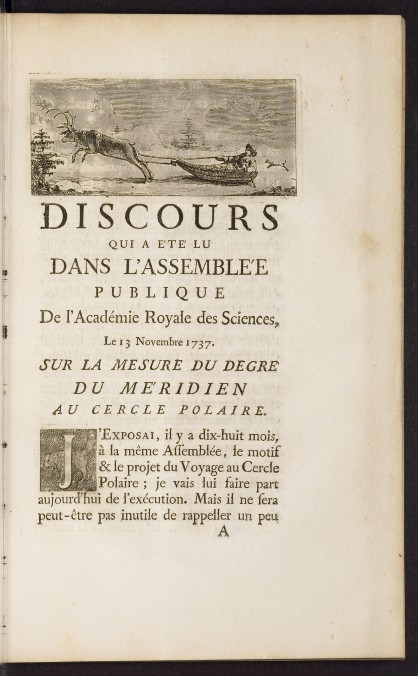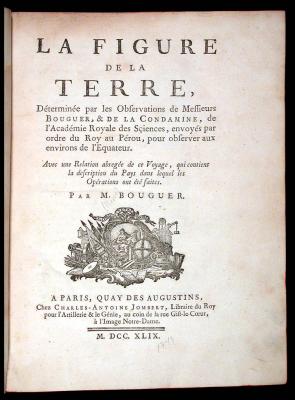|
|
|
|
|
|
|
|
|
|
| MAUPERTUIS, Pierre Louis Moreau de
|
| La Figure de la Terre
|
| Paris: Imprimerie Royale, 1738
|
| First edition.
|
| 8vo, folding map and folding diagrams.
|
| Contemporary calf.
|
|
|
|
|
|
|
| BOUGUER, Pierre
|
| La Figure de la Terre, determine par les observations des Messieurs Bouguer et De La Condamine
|
| Paris: C.A.Jombert, 1749
|
| First edition.
|
| 4to, 12 p.l., cx, [2], 394, 1 leaf; woodcut title vignette, 9 folding engraved plates.
|
| Contemporary calf, gilt spine.
|
|
|
|
|
|
|
| LA CONDAMINE (G.M. de)
|
| Relation Abrege d'un voyage a l'Amerique Meridienale
|
| Paris: Pissot, 1745
|
| First edition.
|
| 8vo.
|
| Contemporary mottled calf, gilt spine.
|
|
|
|
|
|
|
| JUAN Y SANTACILIA, Jorge and ULLOA, Antonio de
|
| Voyage a l'Amerique Meridienale
|
| Amsterdam & Leipzig: Arkstee & Merkus, 1752
|
| Three volumes bound in two, 4to.
|
| Contemporary mottled calf, spines gilt.
|
|
|
|
|
|
|
|
One of the seminal predictions of Newton's theory of gravity is that a rotating, self-gravitating mass such as the earth will be an oblate spheroid - i.e., it will be flattened at the poles and bulging at the equator. In fact, the theory goes further and makes a quantitative prediction of the earth's precise curvature. This became the touchstone of the Newton/Descartes debate - if the earth is in fact an oblate spheroid then Newtonian physics is probably right; if it is a prolate spheroid (contracted at the equator) then Newtonian physics is definitely wrong. As it happens, Cartesian physics doesn't inherently make a rigorous quantitative prescription for the earth's shape one way or the other (although Bernoulli made some calculations in the spirit of DesCartes' vortex model and came up with a prolate spheroid). So the argument in France was mainly about proving Newton wrong. The Cartesians considered that a failure of Newtonian physics would de facto support the Cartesian system, as if they were mutually exclusive and no other system was possible.
|
|
|
|
If the earth is oblate, then a degree of latitude near the arctic circle will be longer than a degree near the equator. The scientific debate over Newton's physics, combined with the cartographic significance of the question, led France to mount two expeditions to measure a degree of latitude at widely separated locations on earth. The Academie Royale des Sciences sent expeditions to Lapland and to Peru to make the measurements. These were extraordinarily ambitious and difficult undertakings that lasted years, exposed the scientists to extremes of climate and physical risk, and required making precise, painstaking geodetic measurements over hundreds of miles of rugged terrain.
|
|
|
|
The expedition to Lapland was led by Pierre de Maupertuis, who had already made a name for himself in physics and astronomy as a leading advocate of Newtonian physics and was a close associate of Voltaire. (So close, in fact, that they shared the same mistress: Mme du Chatelet). The Lapland expedition encountered extreme hardships of climate and terrain, as described in this narrative journal, but was completed with a successful demonstration of flattening at the earth's pole years before the return of the Peruvian expedition. This did not, however, obviate the importance of the Peru results because Maupertuis' extremely partisan support of Newton made his results suspect to many. |
|
|
|
The Peruvian expedition was led by the French astronomers Pierre Bouguer, Charles de la Condamine, and Louis Goudin, and the Spanish military officers Jorge Juan y Santillana and Antonio Ulloa. The measurements took place over a period of ten years, over a distance of hundreds of miles through tropical jungles and up some of the highest peaks in the Peruvian Andes. The expedition leaders were competitive men of high status and strong opinions, who soon fell into discord and separated into competing sub-expeditions, finally reporting their results in three different groups of publications. As with other 18th century scientific expeditions, the members engaged in wide-ranging observations that went far beyond their immediate assignment. Their journals provide a vivid account of the geodetic measurements, the natural history and geological discoveries, and the personal intrigues and adventures with local Spanish and indigenous populations (one expedition member was killed in a village dispute and another married a local Spanish aristocrat's daughter). The descriptions of some of the jungle parasites would make the most intrepid scientist think twice about leaving home.
|



